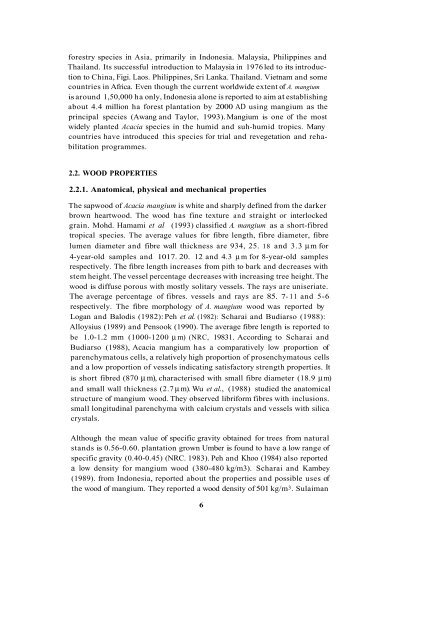growth and wood characteristics of acacia mangium grown in kerala
growth and wood characteristics of acacia mangium grown in kerala
growth and wood characteristics of acacia mangium grown in kerala
- No tags were found...
Create successful ePaper yourself
Turn your PDF publications into a flip-book with our unique Google optimized e-Paper software.
forestry species <strong>in</strong> Asia, primarily <strong>in</strong> Indonesia. Malaysia, Philipp<strong>in</strong>es <strong>and</strong>Thail<strong>and</strong>. Its successful <strong>in</strong>troduction to Malaysia <strong>in</strong> 1976 led to its <strong>in</strong>troductionto Ch<strong>in</strong>a, Figi. Laos. Philipp<strong>in</strong>es, Sri Lanka. Thail<strong>and</strong>. Vietnam <strong>and</strong> somecountries <strong>in</strong> Africa. Even though the current worldwide extent <strong>of</strong> A. <strong>mangium</strong>is around 1,50,000 ha only, Indonesia alone is reported to aim at establish<strong>in</strong>gabout 4.4 million ha forest plantation by 2000 AD us<strong>in</strong>g <strong>mangium</strong> as thepr<strong>in</strong>cipal species (Awang <strong>and</strong> Taylor, 1993). Mangium is one <strong>of</strong> the mostwidely planted Acacia species <strong>in</strong> the humid <strong>and</strong> suh-humid tropics. Manycountries have <strong>in</strong>troduced this species for trial <strong>and</strong> revegetation <strong>and</strong> rehabilitationprogrammes.2.2. WOOD PROPERTIES2.2.1. Anatomical, physical <strong>and</strong> mechanical propertiesThe sap<strong>wood</strong> <strong>of</strong> Acacia <strong>mangium</strong> is white <strong>and</strong> sharply def<strong>in</strong>ed from the darkerbrown heart<strong>wood</strong>. The <strong>wood</strong> has f<strong>in</strong>e texture <strong>and</strong> straight or <strong>in</strong>terlockedgra<strong>in</strong>. Mohd. Hamami et al (1993) classified A. <strong>mangium</strong> as a short-fibredtropical species. The average values for fibre length, fibre diameter, fibrelumen diameter <strong>and</strong> fibre wall thickness are 934, 25. 18 <strong>and</strong> 3.3 µ m for4-year-old samples <strong>and</strong> 1017. 20. 12 <strong>and</strong> 4.3 µ m for 8-year-old samplesrespectively. The fibre length <strong>in</strong>creases from pith to bark <strong>and</strong> decreases withstem height. The vessel percentage decreases with <strong>in</strong>creas<strong>in</strong>g tree height. The<strong>wood</strong> is diffuse porous with mostly solitary vessels. The rays are uniseriate.The average percentage <strong>of</strong> fibres. vessels <strong>and</strong> rays are 85. 7- 11 <strong>and</strong> 5-6respectively. The fibre morphology <strong>of</strong> A. <strong>mangium</strong> <strong>wood</strong> was reported byLogan <strong>and</strong> Balodis (1982): Peh et al. (1982): Scharai <strong>and</strong> Budiarso (1988):Alloysius (1989) <strong>and</strong> Pensook (1990). The average fibre length is reported tobe 1.0-1.2 mm (1000-1200 µ m) (NRC, 19831. Accord<strong>in</strong>g to Scharai <strong>and</strong>Budiarso (1988), Acacia <strong>mangium</strong> has a comparatively low proportion <strong>of</strong>parenchymatous cells, a relatively high proportion <strong>of</strong> prosenchymatous cells<strong>and</strong> a low proportion <strong>of</strong> vessels <strong>in</strong>dicat<strong>in</strong>g satisfactory strength properties. Itis short fibred (870 µ m), characterised with small fibre diameter (18.9 µ m)<strong>and</strong> small wall thickness (2.7 µ m). Wu et al., (1988) studied the anatomicalstructure <strong>of</strong> <strong>mangium</strong> <strong>wood</strong>. They observed libriform fibres with <strong>in</strong>clusions.small longitud<strong>in</strong>al parenchyma with calcium crystals <strong>and</strong> vessels with silicacrystals.Although the mean value <strong>of</strong> specific gravity obta<strong>in</strong>ed for trees from naturalst<strong>and</strong>s is 0.56-0.60. plantation <strong>grown</strong> Umber is found to have a low range <strong>of</strong>specific gravity (0.40-0.45) (NRC. 1983). Peh <strong>and</strong> Khoo (1984) also reporteda low density for <strong>mangium</strong> <strong>wood</strong> (380-480 kg/m3). Scharai <strong>and</strong> Kambey(1989). from Indonesia, reported about the properties <strong>and</strong> possible uses <strong>of</strong>the <strong>wood</strong> <strong>of</strong> <strong>mangium</strong>. They reported a <strong>wood</strong> density <strong>of</strong> 501 kg/m 3 . Sulaiman6
















